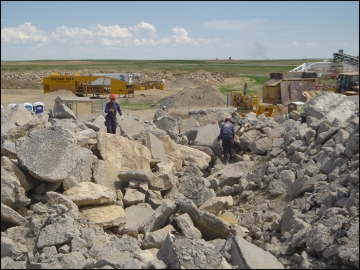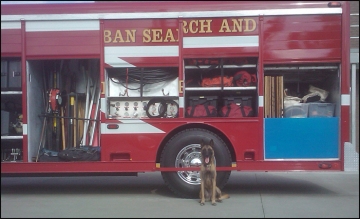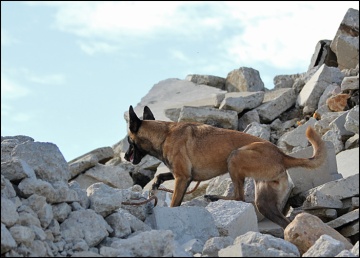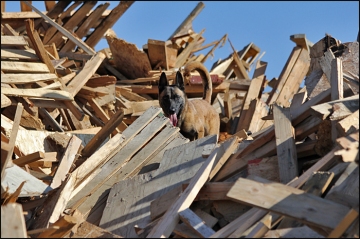I often get asked about how to become involved with Search and Rescue. Usually, someone tells me that their dog is the ultimate search machine and will find them/their toy/food in a matter of seconds, no matter where in the house they are. Or they just got a German Shepherd and are now looking for something to do with their dog. Here is some information about what Search and Rescue training entails. First let’s talk about different areas of SAR. These are some of the more common ones:
- Urban Search and Rescue (Disaster)
 These are the teams who are deployed when disaster hits, such as a tornado, hurricane or earthquake. Just hours after the devastating tornadoes hit Oklahoma City in May 2013, multiple disaster dog teams were on scene, working tirelessly to find survivors, buried underneath rubble piles. Often the dogs work independently from their handlers, sometimes, for safety reasons, the handlers are not even close to the dogs. Usually, these dogs have a bark alert, meaning, they will bark to indicate a live victim. Unlike some of the wilderness SAR dogs, they will not leave the victim and they will wait for the handler to come to them, thus minimizing the risk of navigating the rubble. With the bark alert, they do not need to be in view of their handlers. On occasions, the handler gives the K9 a command to change direction, using hand signals.
These are the teams who are deployed when disaster hits, such as a tornado, hurricane or earthquake. Just hours after the devastating tornadoes hit Oklahoma City in May 2013, multiple disaster dog teams were on scene, working tirelessly to find survivors, buried underneath rubble piles. Often the dogs work independently from their handlers, sometimes, for safety reasons, the handlers are not even close to the dogs. Usually, these dogs have a bark alert, meaning, they will bark to indicate a live victim. Unlike some of the wilderness SAR dogs, they will not leave the victim and they will wait for the handler to come to them, thus minimizing the risk of navigating the rubble. With the bark alert, they do not need to be in view of their handlers. On occasions, the handler gives the K9 a command to change direction, using hand signals. - Avalanche
Avalanche dogs are trained to find survivors of avalanches. Many sources quote the Swiss army to be the first ones to have trained Avalanche dogs and/or date the first incident of a dog finding survivors in avalanches in the 1930s. However, Barry, a famous St. Bernard from Switzerland, saved many lives back in 1800. Here is another link to the history of St. Bernards as avalanche dogs: Smithonian. I fondly remember visiting Barry, who’s body is an exhibit in the Natural History Museum in Berne, Switzerland. Avalanche dogs have a long history not only in Switzerland but in many other countries, who have snow year-round. These dogs efficiently cover a wide area almost impossible for people to search. Nowhere else is time as much of essence as after an avalanche. 66% of avalanche victims die after within the first 30 minutes (Avalanche Survival Curve). Avalanche dogs normally start digging as part of their alert. - Wilderness/Tracking
 Wilderness Search and Rescue is often sent, when hikers have gone missing. In some cases, the teams are looking for physically and/or mentally disabled people (e.g. Alzheimer patients). They have to cover a large, sometimes mountainous area or deep forests. Tracking dogs, much like disaster dogs, do not have a specific person’s scent – they are to find any live person in distress. Unlike disaster and avalanche dogs, they are usually trained not to stay with the victim, but to come back to the handler. Their alert varies, but a common alert is to take an object from their collar into their mouth and bring it to their handler (Bringsel). Tracking dogs often are out of their handlers view, working independently through brushes and obstacles.
Wilderness Search and Rescue is often sent, when hikers have gone missing. In some cases, the teams are looking for physically and/or mentally disabled people (e.g. Alzheimer patients). They have to cover a large, sometimes mountainous area or deep forests. Tracking dogs, much like disaster dogs, do not have a specific person’s scent – they are to find any live person in distress. Unlike disaster and avalanche dogs, they are usually trained not to stay with the victim, but to come back to the handler. Their alert varies, but a common alert is to take an object from their collar into their mouth and bring it to their handler (Bringsel). Tracking dogs often are out of their handlers view, working independently through brushes and obstacles. - Wilderness/Trailing
Just as Tracking dogs, Trailing dogs search for lost persons. The difference is, Tracking dogs are trained to follow a specific odor, making them the number one choice K9s for Law Enforcement searching for criminals. If the dogs are handled by the Police in search of a felon, they are most likely trained to apprehend and bite – unless they are Bloodhounds. In which case the found person may get slobbered. 😉 - Search and Recovery
Search and Recovery is just as important as rescuing people. For families and friends, it is crucial to get closure and to be able to recover the body of the missing person. For Law Enforcement, Search and Recovery can solve a crime. Recovery dogs can be trained to find crime scenes, blood, bones (including historic bones, such as old burial grounds, etc.) and dead bodies. Some of these dogs are efficient water dogs, working on boats to find bodies underwater.
All these dogs have one thing in common: they can efficiently do the job of many people and machines. Some say, one dog is as efficient as 150 people. They are able to cover a large ground in a short time. And their noses are an invaluable tool to save lives.
 Now we get to the next subject – the dog. Finding anything in the house does not make a dog a blooming star on the K9 SAR sky. Focus and drive are necessary, but also the ability to work independently, fearlessness, balance to navigate difficult terrain (think piles on piles of rubble and wood or fields of snow), willingness to stay on odor and at the victim, be absolutely trustworthy with strangers (solid temperament) and most importantly, work tirelessly and focused even under stress. Ideally, a dog is not older than 2 years, when SAR training starts. Never had a broken limb or a seizure. They can’t be tiny or they won’t be able reach every inch of a rubble pile. They can’t be too big either or they won’t be as agile.
Now we get to the next subject – the dog. Finding anything in the house does not make a dog a blooming star on the K9 SAR sky. Focus and drive are necessary, but also the ability to work independently, fearlessness, balance to navigate difficult terrain (think piles on piles of rubble and wood or fields of snow), willingness to stay on odor and at the victim, be absolutely trustworthy with strangers (solid temperament) and most importantly, work tirelessly and focused even under stress. Ideally, a dog is not older than 2 years, when SAR training starts. Never had a broken limb or a seizure. They can’t be tiny or they won’t be able reach every inch of a rubble pile. They can’t be too big either or they won’t be as agile.
Dogs like that are very, very rare. In fact, if you know of one who’s looking for a home, please don’t hesitate to contact me! I picked the title ‘Turning a Rescue into a Rescuer’ because many SAR dogs are shelter dogs, rescued from high kill shelters, often dumped there by people, who were not able to handle such energy. One organization who focuses on training such dogs is the non-profit National Search Dog Foundation. They provide trained K9s to handlers from FEMA teams nationwide since 1995.
Now that we established the type of dog we need for SAR, let’s have a look at the other end of the leash, the handler. SAR training and work is not for the couch potatoes, we all know that. But are you able to climb a ladder with your dog on your shoulders? Work hours after hours in burning heat on a pile of broken concrete slabs or dig through a mountain of wood pallets including rusty nails until you’re on top of it? Hike for days or run through forests, steep hills or ski through treacherous snow? And if the answer is yes, are you ready to commit almost all your free time to training – you and your dog? Spend money on gas and seminars, books and equipment and not ever expect to be paid back? Are you able to leave work on a moment’s notice to be deployed for an unknown amount of days or weeks?
Hike for days or run through forests, steep hills or ski through treacherous snow? And if the answer is yes, are you ready to commit almost all your free time to training – you and your dog? Spend money on gas and seminars, books and equipment and not ever expect to be paid back? Are you able to leave work on a moment’s notice to be deployed for an unknown amount of days or weeks?
If you are still interested in joining a SAR group, contact your local Sheriff’s department, a fire department or a SAR organization in your area, such as CARDA. They might invite you to take part in their training for a while before they (and you) commit. Many teams will gladly accept help in form of ‘victims’, who pose for their dogs. There is much to be learned while playing victim! Many groups are also always looking for new training grounds. Some teams may have open trainings and often times will allow the public to watch certifications.
For even more in-depth information, click here for an online class about K9 SAR.
